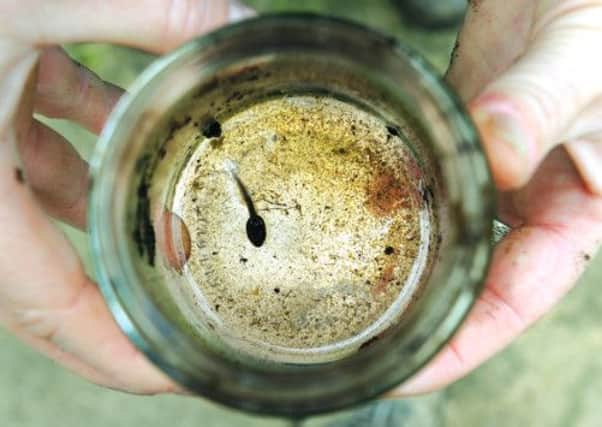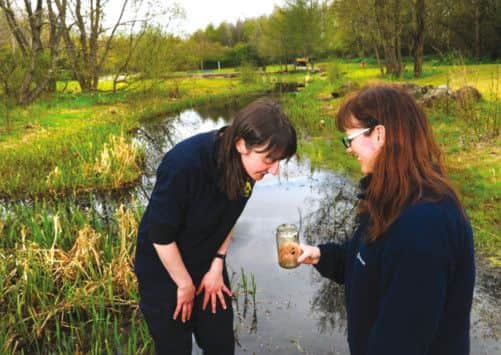Anna Burnside: It’s a frog’s life


IT’S spring. Isn’t it? Heavy coats should be at the dry cleaners. That big yellow hot thing that we vaguely remember should be high in the sky. And ponds, puddles and everything in between should be awriggle with tadpoles, shaking their tails, preparing to sprout legs and hop forth into the world. (Or to be captured in a jam jar by a curious herpetologist-in-the making, and hand-reared in a smelly bucket in the kitchen.)
Sadly life is not a Janet and John reading book, the skies are grey and the few tadpoles there are in Glasgow’s Festival Park have spotted the incoming jar and are hiding in the weeds. Even if children did prefer living, slithering beasties in recycled receptacles to animated Moshi Monsters on their iPads, home-rearing is now frowned upon. Moving amphibians from their home pond can spread redleg, a nasty virus probably brought into the UK by American bullfrogs imported as pets.
Advertisement
Hide AdAdvertisement
Hide AdThis being Britain, we can start by blaming the weather. The mixed climatic bag that was February and March saw off a good deal of early frogspawn. The temperature rose, the frogs decided to get it on. Nature took its course and countryside rangers Jackie Clark and Fiona Greenlees, who monitor the ponds of north-west Glasgow, spotted clumps of eggs at the beginning of February. Then the frost arrived. Game over.


Greenlees, who regularly introduces urban schoolchildren to the wildlife that lives outwith electronic devices, explains: “They do have anti-freeze in their jelly. It’s enough for them to cope with a light dusting of frost. But not a big freeze.”
A sustained drop in the temperature can also wipe out adult frogs, which may hibernate in the soil at the bottom of a pond. They can cope with ice – as long as light is getting into the area, photosynthesis will carry on beneath the surface and there will be oxygen in the water. A layer of snow on top, however, brings darkness. The water becomes deoxygenated and the frogs have had it.
Happily some less concupiscent amphibians wait for the temperature to stabilise. This year it’s those that managed to hold on until the end of March that will be keeping the common frog and toad species going.
Adults see frogspawn and get misty -eyed and nostalgic about tapioca pudding and guddling about in a burn. Frogs provoke warm memories of Kermit and the innocent days when a boy thought putting a particularly warty toad down the back of a girl’s dress was a good way to make an impression. Hedgehogs and birds, however, do not. Show newts and waterborne insects such as dragonfly nymphs and riverboatmen some frogspawn and they turn into stoned students at the all-you-can-eat buffet. In garden ponds, ornamental koi carp will not only have a go at spawn, but carry on as it develops into tadpoles. Even cats will give spawn a try: amphibians lay their eggs in the shallow edges of ponds, or puddles, where the water is warmer. The most aquaphobic moggy will dip its paw into a puddle if there is a scrumptious morsel in it for them.
Countryside rangers, who look after the whole ecosystem and are not allowed to play favourites, cannot afford to be sentimental about this. “Herons and ducks, in fact all wetland birds, eat spawn,” says Clark. “Newts eat tadpoles, they are a very nutritious food source for them. Otters and herons eat frogs.”
Apart from the heron in Kelvingrove Park, that is, which is fed tinned sardines by an elderly gentleman every day. This is not in any way good for the bird’s health but it does give nearby amphibians a day off.
In the absence of other food sources, frogs have no qualms about eating each other. Many a primary school teacher has had to face a primary two class which left a full tank of squirming froglets on Friday afternoon and came in on Monday morning to single figures.
Advertisement
Hide AdAdvertisement
Hide AdThe frog’s position as so many predators’ healthy snack of choice is one reason why it’s such a prolific spawner. Clark recalls rescuing some in Pollok Country Park. “There was a hard frost so we brought the frogspawn inside. It was in a good-sized tank. We gave them fish food. As the tadpoles developed, we took the tank outside to let them get used to the temperature. Then we released them out into the wildlife pond.”
How many mature frogs emerged from a bucketful of spawn reared as a text-book example of amphibian husbandry? In an environment that was heron and hedgehog-free? Three.
Even so, Festival Park, one of the sites left as a green space after the Glasgow Garden Festival in 1988, should be hopping with amphibian life. It is just up from the southern bank of the Clyde, tucked across the road from the Science Centre and the BBC. The pond has been left to its own devices since the last century.
Clark and Greenless look approvingly at its boggy edges: ideal spawning spots. “There is fantastic vegetation, water mint, irises.” (The water mint might not last long when the BBC staff at Pacific Quay realise that one of Tom Kitchin’s favourite ingredients is growing wild across the road.) “The froglets use the vegetation to climb on. And it provides plenty of food sources for them.”
So as well as looking very bonny, this cuts down on cannibalism.
Festival Park has its own wooded area where the adult frogs and toads live outwith the spawning season. This is, crucially, accessible without having to cross a road. Those red triangle warning signs with the big old toad on them are not a joke: motor vehicles wipe out as many amphibians as herons and ducks. Their natural camouflage, designed to confuse predatory birds, works just as well with drivers.
In Pollok Country Park, when its time for the toadlets to leave the fish pond, volunteers in hi-vis jackets stop the traffic and make sure the young toads make a safe getaway to the woods on the other side of road. “There are literally thousands of them,” says Greenlees. “The tarmac looks as if it is moving.”
It is hard to imagine the soupy water of Festival Park’s pond springing into life. Within its murky shallows it is just possible to detect some pockets of tadpoles shimmying and flickering. The adults, however, are well out of sight. Turns out that in the real world (in this case Govan) frogs do not recline on lilypads. Neither do they perch on toadstools, wear miniature bow ties, go fishing with tiny rods or hang out with bottle-blonde pigs. Can they be transformed into princes? Didn’t look much like it. There were none of them around either.
Advertisement
Hide AdAdvertisement
Hide Ad“The water is actually a dangerous place for frogs and toads,” says Greenlees. “They are too exposed there. They must be near the water – they can smell it from two miles away – and they need to come back to it. But as soon as they have spawned they return to their holes in the earth. They actually live in dank, damp places, sometimes several miles away.”
Glasgow City Council has 29 ponds within its parks. Eleven of these are “scrapes”, spots which regularly gathered water, which the council has persuaded the landowner to deepen into a year-round pond. “It doesn’t need much water,” Greenlees explains, “and any pond raises the biodiversity of the area by a factor of 10. It brings a whole ecosystem with it.”
Two former boating lochs, Hogganfield and Bingham Pond, have been “naturalised”. Once grey concrete council puddles with grumpy attendants and creaky pedalos, these are now wildlife oases. The rare Slavonian grebe has been known to drop into Hogganfield Loch, in the well-known nature reserve of Robroyston. It has become the city’s most important location for migrating and over-wintering birds.
In Glasgow Botanic Gardens a few years ago, a pond was removed during renovations. The frog population, however, missed this memo and continued to return in search of their spawning spot. The pond has since been reinstated.
Amphibians, however, do not need a vast expanse of water. Greenlees has a “tiny” pond in her own garden. She counted 61 frogs in 2011 and 50 in 2012. This year, the early spawn went white and mouldy and failed to make it. The spawn of the later maters, however, has been more successful and she reports “plenty of big tadpoles so far”.
Not everyone is delighted to find visitors hopping about in their garden. “We get lots of calls from people who have hundreds of frogs in their ponds and want us to take them away,” says Clark. “We try to reassure them that they’ll only be there for a week or two, then most of the froglets or toadlets disappear. Or they bring us in buckets of newts.” Clark and Greenlees do their best and release them into their wildlife pond but the prognosis is not good. “When they are out of their home territory, they have a poor chance of survival.”
But those grown-ups who appreciate the amphibian things in life (such as Germaine Greer, who recently announced “happiness is frog-shaped”) really love them. Clark reports that, when she and colleagues hold pond-dipping events across the city, demand is huge. Two years ago at Festival Park she had to draft in extra staff when 50 people turned up in the first half hour.
“The kids don’t get a look-in,” she says. “The adults are down to the front, with the nets, shoving the kids out of the way. There are few more enjoyable things in life than messing about in a pond.” «
Twitter: @MsABurnside